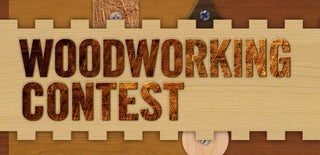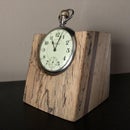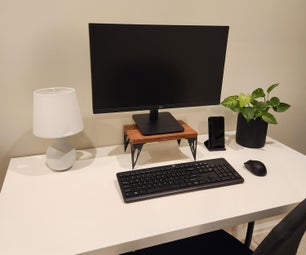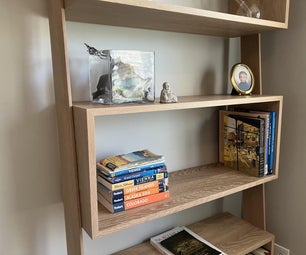Introduction: Flat Stacking Cookbook Stand
Hell hath no fury like a Woman's scorn for a cookbook lying flat on a table that won't stay open. She turns to reference the recipe as the pages snap shut like a bear trap. What was that page number? No one knows ... and it's going to take at least three flip throughs to find it again. Meanwhile, something is burning ... something is missing ... something else isn't cooking at all.
Wisk in one hand, knife in the other, flour everywhere, hair so messy you'd think she just got done wrestling a lion, and words you haven't heard since you tracked mud across Mom's freshly vacuumed carpet because you almost missed the opening sequence of The Dukes of Hazzard.
Why is it that within an entire kitchen, the wet ingredients always have to end up on the recipe and always on the information you need at that exact moment?
All I wanted was another beer, but there was no way I was entering that Thunderdome. Something had to be done. I couldn't risk future instances of this culinary induced prohibition. In hindsight, a small cooler for the living room would've been easier and much faster, but I was frazzled and not thinking straight. My liver said, "BEER! You can do it! Just dodge and weave like Indiana Jones," but my brain said, "Cookbook Stand that slides together like a puzze for flat storage!"
Step 1:
I'll be honest ... I had a design in my head, but I wasn't sure how/if it was going to actually work. I needed a mock up to work out all the details. I chose cardboard because it was there, it's cheap, it's easy to cut, and it holds it's shape. Once I had a working model, I made templates out of hardboard. This way if I messed up, I wasn't wasting my nice plywood and I could use these templates and a pattern bit to make the final product. I also figured there might come a time when I need to make more of these ... therefore, saving more men from a beer blocking, kitchen devil.
Step 2:
I started off by cutting the plywood to width and left the overall length long so that the height and tilt angle could be determined later. I then secured my templates to the plywood with carpet tape and made a few relief holes in the narrow recesses using a forstner bit on the drill press.
Step 3:
The bulk of the material was removed using the bandsaw. For the area that has no entry point, I used the jigsaw. Remaining material was removed with a pattern bit on the router table. To square up the rounded corners, I went back to the bandsaw. I probably should've used a coping saw (didn't have one at this time) or a chisel (I only have one and it is very cheap/abused/useless), but I didn't.
For the graduated holes (they do have a function ... be patient ... all will be revealed), I used a forstner bit on the drill press and then rounded over the edges on the router table.
For the angled bottoms, I just eyeballed it and snuck up on the cut, using the tablesaw, until I got a visually appealing tilt angle.
Step 4:
After some sanding, I oiled the boards with 50/50 Boiled Linseed Oil and Mineral Spirits. I decided I wanted a red stripe to add a little flair or color, so I masked off a section and laid down a few coats of spray paint.
First Lesson: masking tape pulled up some of the oil, so I had to do some touch ups.
Second Lesson: I had transferred a graphic from a laser printer onto the wood using acetone, which was successful. However, the touch up pass of oil pulled some of it out. I actually liked the ghosted effect, so it worked out.
Once the oil dried, I topcoated with multiple passes of spray lacquer.
Step 5:
I needed a method for keeping the book or magazine open. If it closes, it defeats the purpose. More importantly ... if it closes, there is going to be more cussing and another beer drought.
My initial idea was a simple wooden dowel at each end, but I know my luck ... the book in question is going to be smaller than the spacing I pick ... or the dowel will obstruct the view, tempers will rise, and the flow chart puts us right back to me having no beer. I needed a solution that spanned the entire width and didn't conceal text. I needed plexiglass! It just so happens I know people in powerful positions ... like the hardware section of Lowes ... so I got this cutoff section of 1/4" plexi for $10.
I ripped it to width and length on the tablesaw using a Freud blade, which is made specifically for acrylic. A regular blade will leave all kinds of nasty chipping and those fragments hurt as they ricochet off of your skin. Once cut, I drilled some equidistant holes 3/8" in from one edge. These holes were transferred to the plywood using and awl and predrilled for the screws. I used stainless steel screws and a screwdriver ... manual .. old school ... I walked uphill to and from the workbench as well.
Step 6:
After the lacquer cured, I did wet sand, wax, and buff this creation, but I didn't take any photos. You'll have to take my word on it.
As you can see, the pieces interlock to form the stand. It can be taken apart quickly and easily for space saving storage or travel. It can hold a book for reading ... or a tablet.
What is the purpose of the graduated holes? That my friend ... that is an integrated spaghetti serving measurer. Oh yes ... 1-4 serving sizes. "Do I really need and/or want a spaghetti serving measurer?," you might ask. The answer is YES ... yes you do. The hole on the back leg does nothing. It's just there to carry the theme. That's what designers say right? I just make it up as I go.

Participated in the
Woodworking Contest

Participated in the
Full Spectrum Laser Contest













